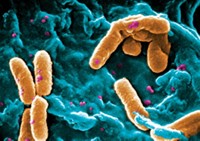Advertisement
Grab your lab coat. Let's get started
Welcome!
Welcome!
Create an account below to get 6 C&EN articles per month, receive newsletters and more - all free.
It seems this is your first time logging in online. Please enter the following information to continue.
As an ACS member you automatically get access to this site. All we need is few more details to create your reading experience.
Not you? Sign in with a different account.
Not you? Sign in with a different account.
ERROR 1
ERROR 1
ERROR 2
ERROR 2
ERROR 2
ERROR 2
ERROR 2
Password and Confirm password must match.
If you have an ACS member number, please enter it here so we can link this account to your membership. (optional)
ERROR 2
ACS values your privacy. By submitting your information, you are gaining access to C&EN and subscribing to our weekly newsletter. We use the information you provide to make your reading experience better, and we will never sell your data to third party members.
Environment
Nanoparticles Worm Their Way Into The Food Web
Nanomaterials: Earthworms can accumulate gold nanoparticles from soil
by Laura Cassiday
October 7, 2010

Scientists know little about how releasing some of the more than 2 million tons of nanoparticles produced every year will affect organisms in the environment. A new study reports that earthworms (Eisenia fetida) can ingest gold nanoparticles from their surrounding soil and accumulate them in their tissues—a finding with significant implications for food webs (Environ. Sci. Technol., DOI: 10.1021/es101885w).
Manufacturers add nanoparticles to cosmetics, clothing, and medical devices. Normal use of these products—such as washing your clothes—can release nanoparticles into wastewater, where they end up in sewage sludge. In the U.S. and Europe, farmers apply sewage sludge to their fields as fertilizer.
Environmental toxicologist Jason Unrine of the University of Kentucky, Lexington, and colleagues wanted to know if nanoparticles applied to these fields eventually made their way into the food chain. "Because we expected the nanomaterials to aggregate onto soil particles, we were initially very skeptical that organisms could take them up from the soil," Unrine says.
To find out, Unrine's team mixed earthworms—organisms near the bottom of the food chain—into artificial soil tainted with gold nanoparticles. "We used gold nanoparticles because they’re stable, insoluble, and easily detected," Unrine says. "They make a good tracer."
After 28 days, the researchers investigated the worms' tissues to look for uptake of nanoparticles. The scientists first performed laser ablation inductively coupled plasma mass spectrometry (LA-ICP-MS) to map the total gold distribution in earthworm tissues. Then they used a more time-consuming technique called synchrotron-based X-ray microspectroscopy on selected regions to confirm that the gold was in metal form and not ionic gold left over from the manufacturing process.
Unrine and his colleagues found 20- and 55-nm diameter gold nanoparticles distributed throughout the worms' bodies with the highest concentrations in their guts. But the exposed worms did not upregulate the gene for metallothionein, a metal-ion–sensing protein, further confirming that the gold detected in earthworm tissues was in nanoparticle form.
Although the gold nanoparticles didn't significantly affect earthworm mortality, exposed worms produced up to 90% fewer offspring. Unrine plans future studies to more closely examine the biological responses of earthworms to nanomaterials.
"This study provides the best evidence to date of nanoparticle uptake into tissue from soil," says Robert Hurt, an environmental engineer at Brown University. And he thinks the study could have significant implications: "Nanoparticles are typically found at low concentrations in the environment, but they will have a greater potential to harm human health if they biomagnify in the food chain."




Join the conversation
Contact the reporter
Submit a Letter to the Editor for publication
Engage with us on Twitter